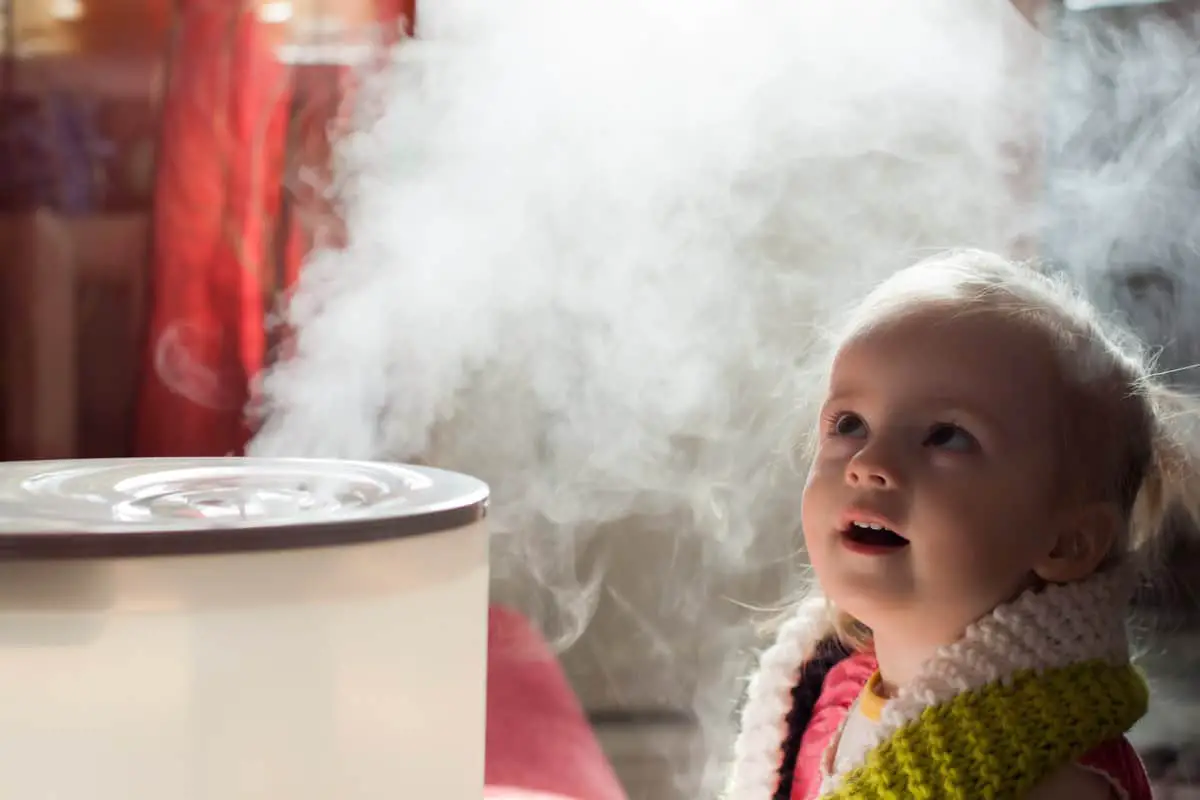Have you ever noticed that your eyes are dry, having been staring at a computer screen for hours? I know I have. This is due to not blinking enough but is worse in air that is very dry. People may also notice dry skin and mucous membranes in the mouth and nasal passages. Nose bleeds can even be a sign of low humidity. It can also lead to increased breathing difficulty for people with some respiratory conditions. These can all be made better by increasing the humidity of the air.
Humidity is measured as relative humidity on a scale from 0 to 100. We are most comfortable at a relative humidity of 30-50. Humidity is lowest in our homes during the winter. When the outdoor temperature is low, the rate of evaporation is low, leading less water vapor in the air, hence dry air.
Fortunately, it is possible to make our homes more comfortable by controlling our indoor humidity with humidifiers.
Humidifiers add moisture to the air but do not improve air quality in terms of reducing air pollution. They do not reduce either particle or chemical pollution to a significant extent.
There are four different types of humidifiers plus the option of building a humidifier into your HVAC system. They fall into 2 groups, those that heat the water and those that do not. All 4 types can produce excellent humidification.
Although there are 4 types, they have certain characteristics in common.
All The Different Types of Humidifiers Have Two Basic Ways of Getting Water Into The Air: Evaporation or Forming Droplets
Humidifiers can use evaporation to get pure water vapor into the air. In a sample of water, different water molecules have different energies. Occasional water molecules have enough energy to escape from the surface of the water into the air. This is how evaporation occurs. In this situation, single molecules are leaving the surface of the water and they are far too small to take any impurities or minerals with them.
The other way that humidifiers can send water into the air is by creating water droplets which are thrown into the air.
The problem with devices that send water droplets into the air is that impurities in the water that forms the droplet will go with the droplet into the air. You may then breathe in these droplets with impurities. The impurities can include minerals, which when the droplet settles on your furniture or floor and dries out leaves a white deposit. This is a particular problem in hard water areas, as there are more minerals in the water.
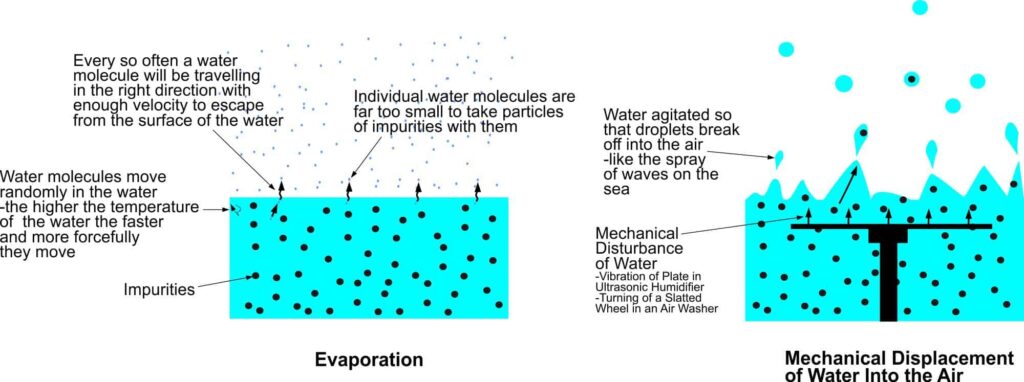
Other sorts of impurities for instance biological agents such as bacteria or fungi may grow in the water in the humidifier or diffuser. It can also include allergens that have got into the water from the air flow through the humidifier. These can then be sent into the air in droplets and breathed in by anyone in the room but are a particular problem for asthmatics. This can rarely cause widespread inflammation in the lungs “Humidifier Lung“.
There is also a health problem with minerals in the water. There is a case report of the lungs of a young child being damaged by an ultrasonic humidifier. Also, in a laboratory study particles of minerals were seen in the lungs and there were some associated changes in cellular function in the lungs but no severe inflammation. So it was concluded that only distilled water should be used.
In addition to using distilled or at least filtered (not simply jug filtered) water in the humidifier, having a regular and frequent cleaning schedule is needed to prevent the above problems.
Humidifiers That Heat the Water-Potential Danger For Children or Pets But Quiet
“Warm Mist Humidifier” = Steam Vaporizer = Steam Humidifier
Warm mist humidifiers use heating elements to form steam, which escapes from the top of the humidifier. They may have a small fan to help the steam escape. So they are quieter than evaporative humidifiers.
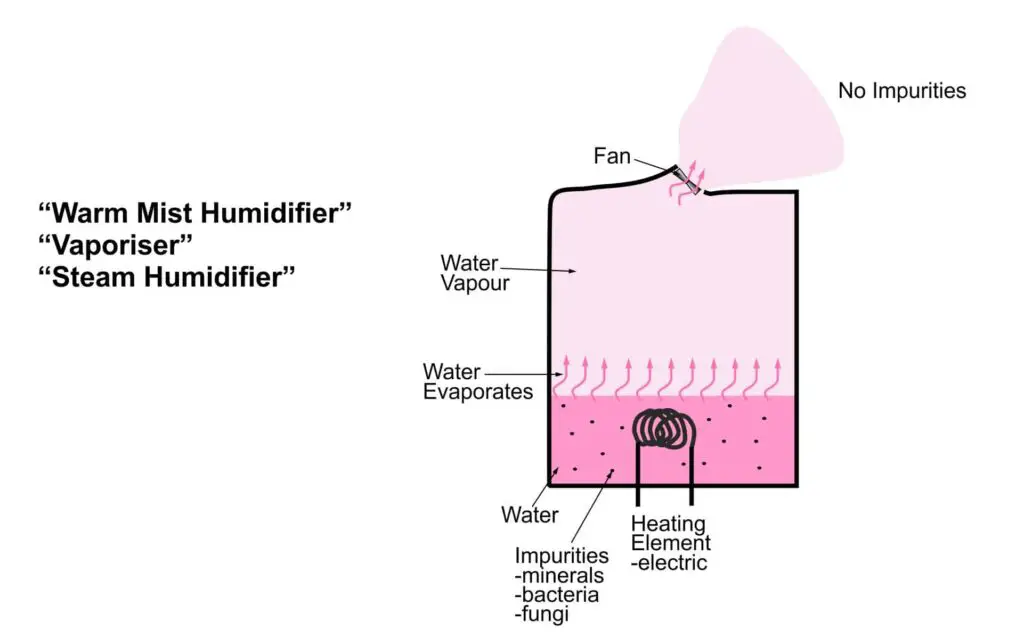
They need to have a reasonably sized water tank, a 1 gallon tank will last 10 hours or so. Because they have a heating element, they need to have an automatic cut out to switch off when the water no longer covers the heating element.
Humidifiers that heat the water are not so suitable for homes with young children or ground-level pets. The steam from a warm mist humidifier or vaporizer may scald a child if they explore the steam coming from it. Hopefully, they would not get the steam in their eyes by falling onto the humidifier. There is also is a risk that the child or pet will knock the humidifier over. This could cause escape of some hot water and injury to a child or pet. Manufacturers do their best to prevent this. Nonetheless, it seems sensible if you have young children in the house to have a cold water humidifier.
The steam can warm air in the room, which could be either an advantage or disadvantage. It depends on the home and whether one of the occupants has an irritating skin condition such as eczema or psoriasis.
An advantage of warm mist humidifiers is that boiling the water means that bacteria and fungi cannot grow in the water. So the maintenance schedule recommended by Healthline is slightly less demanding for “warm mist” humidifiers-
- Every day-empty out the water and dry all surfaces of the humidifier.
- Once a week-empty the tank and then fill with 3 1/2 inches of white vinegar for 10 minutes. Then empty the vinegar out and clean off any residue with a cloth and mild detergent.
Cold Water Humidifiers-Potential for Bacteria and Fungi to Grow in the Humidifier Water
Humidifiers that Use Cold Water and Produce Water Droplets-
1) Ultrasonic Humidifier
These use ultrasound to agitate the water so that small drops are jettisoned into the air as a fine mist. The ultrasound is a very high frequency wave created by applying an electric current to a crystal. The crystal then vibrates and is connected to a plate, which then makes a larger area of water vibrate and throw off droplets.
An ultrasonic humidifier is the quietest type of humidifier, usually not audible even in a quiet room. Humans can hear sounds with a frequency up to 20,000Hz, dogs up to 40,000Hz and cats up to 60,000Hz. These purifiers vibrate the water at 1-2 megaHz so even your pets will not be able to hear them.
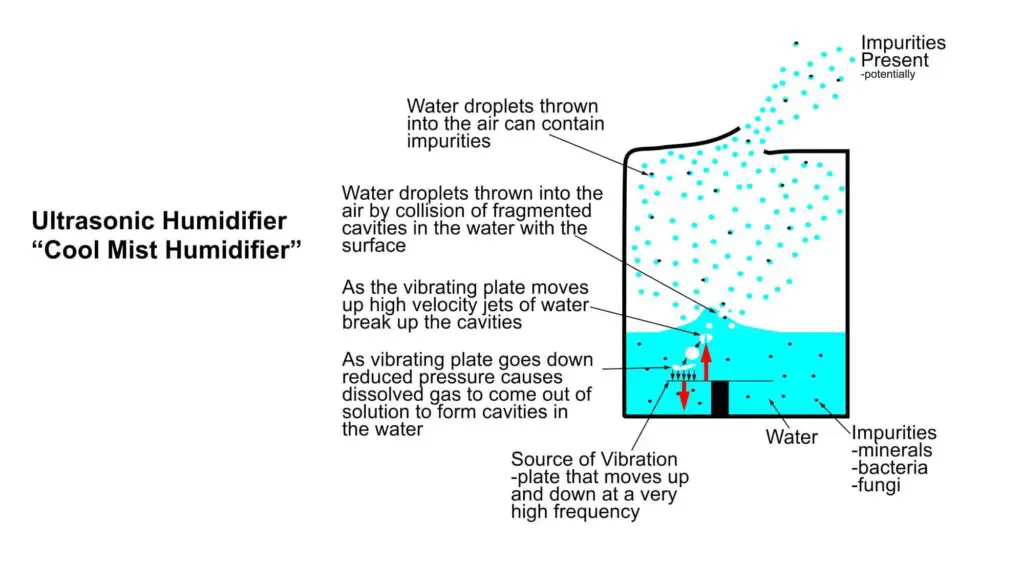
The problem with ultrasonic humidifiers is that they work by splashing water droplets into the air. This means that any mineral impurities, bacteria or fungi in the water will end up in the air. The water droplets when they settle on everything in the room can dry to leave a white deposit of the minerals behind.
Also, the bacterial or fungi in droplets in the air can be breathed in by anyone in the room. Some manufacturers include filters to remove minerals and ionized silver to prevent growth of bacteria.
The best approach to preventing the growth of bacteria and fungi in addition to cleaning the humidifier regularly is to use distilled water. This is produced by evaporation and so has no minerals initially so if microorganisms do land in the water when it is still clean they cannot grow.
Some models are relatively small and can be used as tabletop humidifiers.
An ultrasonic humidifier should be emptied and dried off at night once per day. This will help prevent bacterial and fungal growth.
2) “Air Washer” =Impeller Humidifier = Cool Mist Humidifier,
A cool mist humidifier also produces water droplets and so has the same problems with anything in the water in ending up in your lungs or spread over the room.
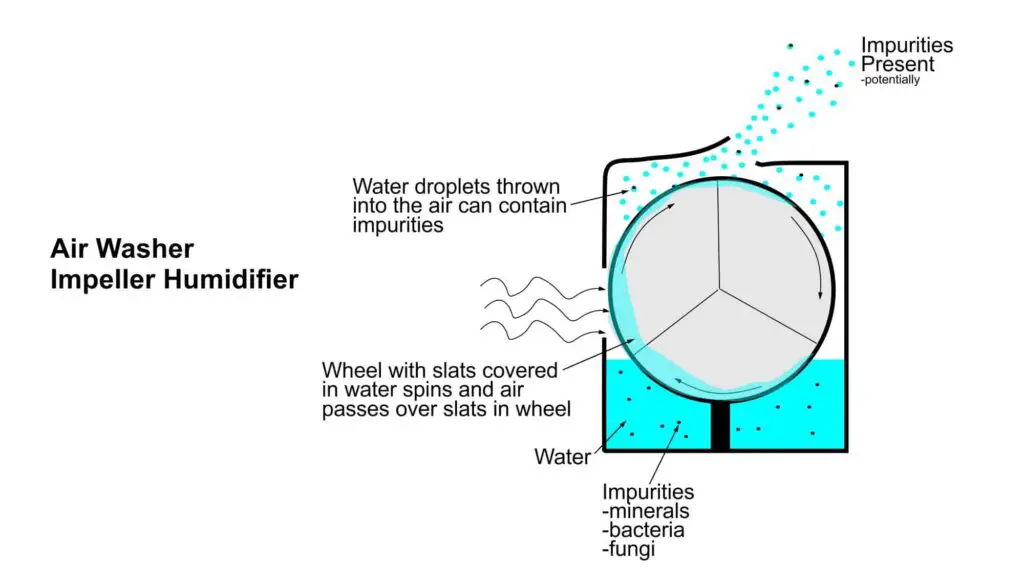
The name is misleading, although these washers do spray water through the air this will not reduce particle pollution in the air sufficiently to protect health. Some models have filters but these are not usually true HEPA specification in which is the minimum necessary to reduce particle count enough to help with health.
Humidifiers that Use Cold Water and Do Not Produce Water Droplets-
Evaporative Humidifier = “Wick Humidifier”
In an evaporative humidifier, air is blown through a wick filter that is soaked with water. The water evaporates into the air to increase the humidity of the air.
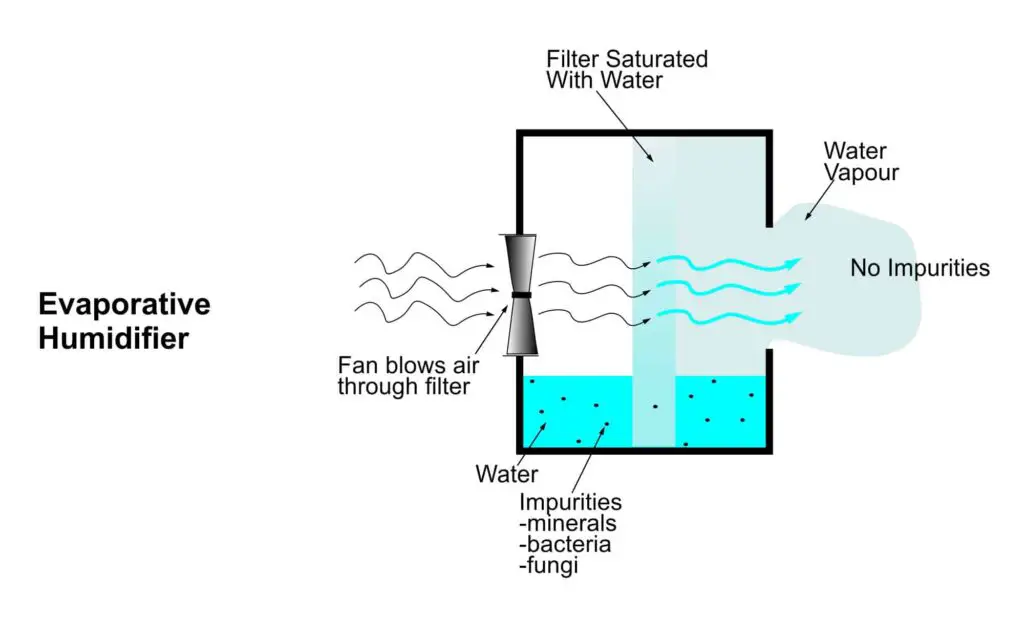
The cleaning schedule that Healthline recommends is the same for all cold water humidifiers-
- Every day-empty out the water and dry all surfaces of the humidifier.
- Twice a week-empty the tank and scrub all surfaces of the humidifier with dish soap. Rinse off the soap, dry the surfaces, and then fill the humidifier with distilled water. Distilled water is used to avoid even a few bacteria such as may be present in tap water getting into the humidifier. It also avoids salts and organic material which the bacteria could use to multiply being present. Bacteria can double in number every 20 minutes in a good growing medium, so in 24 hours one bacterium can turn into 1,000,000,000,000,000,000,000 bacteria. So by using distilled water you make sure you are not introducing any bacteria in the water and you are giving them very adverse conditions in which to try to survive and multiply.
All humidifiers require much more maintenance than that for air purifiers which I outline in this article.
Different Humidifier Control Mechanisms
Personally I would buy a humidifier with a humidity sensor which will determine the humidifier off when the humidity level has reached a set level. This control is sometimes referred to as humidistat. It prevents the humidifier causing a very high humidity, which can interfere with air purifier filters and even promote the growth of fungi-“mold”.
Humidifiers should also have an automatic cut off that switches them off if they run out of water. Especially in the case of a warm mist humidifier this may prevent a fire.
Whole House Humidification with Console Humidifiers
One alternative to having several portable humidifiers is to have a large “console” humidifier. A console humidifier is large but can be has wheels so that it can easily be moved around. It is not really a portable humidifier. These “whole house humidifiers” are large machines on wheels not connected to the HVAC system. They usually have large tanks of approximately 5 gallons – this will last several days. They need cleaning at least once a week and have filters and wicks which will need replacing approximately once every 3 months.

Whole House Humidification With Your HVAC System
This is the most expensive but best humidification system for an entire house. There are 3 main types connected to your HVAC system. The 3 main types are a bypass humidifier, power humidifier or a steam humidifier. The humidity can be set on an HVAC control much as the temperature can be set.
There are some possible problems, for instance, the possibility of condensation collecting in the ducting system. This can then lead to the growth of fungi and bacteria in the ducts. Also of course in the short-term installation of an HVAC humidifier will be more costly.
Further details can be found in this article.
A Diffuser is Different from a Humidifier
A diffuser for essential oils is different from a humidifier in that it does not put so much water into the air. Some diffusers do not use water at all, and those that do not use enough to make a significant difference to the humidity of the room.
Why Not Use House Plants to Humidify Your House?
All humidifiers need maintenance. They need daily water changes, often with distilled water. They also need either twice-weekly or weekly cleaning. There is also the inconvenience and expense of buying distilled water for many types of humidifier. There is also the expense of the electricity to run the humidifier.
So is there an easier way? For many homes it may be worth trying houseplants. Water will evaporate from the soil in the pots and the leaves into the atmosphere. One disadvantage of this approach is that fungi can grow on the surface of the soil and contaminate the air. This is not usually a problem and can be minimized by putting a layer of stones or gravel on top of the soil in the pot. Of course, pot plants can also add a design element to a room.
There are other benefits. Interaction with indoor plants is been shown to reduce stress and anxiety in young adults. So they are also good for mental health.
The plants will probably only need watering once per week and feeding once per month. Simply feed the plants by putting a small amount of plant fertilizer in the water. They also need a reasonable amount of light and so will not be suitable for all rooms. Most houseplants will also need watering at least once per week, which will mean someone to water them if you go on holiday for more than a week.
It is possible that the air in your home will be too dry even for plants! When the plant is in a low humidity atmosphere water will evaporate at a faster rate from its leaves. It therefore needs to transport more water from the roots up to the leaves. So you may need to water the plants more frequently. If you forget, they will tolerate some dryness during the winter, when the humidity is low. This is because they are relatively dormant during the winter. However, if you notice brown ages to the leaves, or flower buds falling off then the humidity is too low for the plant and you will need a humidifier.
Conversely, a humidifier will probably only be needed for some weeks during the winter and so have a shorter period for which they need maintenance. So you may prefer to have a humidifier.
Conclusion
Humidifiers can make your home more comfortable, but they will not improve pollution levels in the home significantly, if at all. For this you need an air purifier with at least a HEPA filter. Still, humidifiers can be helpful for comfort if the humidity in your home is below 30%. By adding water to the air they can improve dry skin, dry mucous membranes and even breathing in some people with respiratory conditions.
There are 4 different types of humidifiers, some of which are not suited to certain homes. If you have children, you are probably safest choosing an evaporative humidifier. Otherwise, a steam humidifier is arguably best. This is because bacteria and fungi are less likely to grow in the water and end up in your lungs. On the flip side, a steam humidifier consumes more electricity than the other types..
Here is a diagram to help you in deciding which to buy-
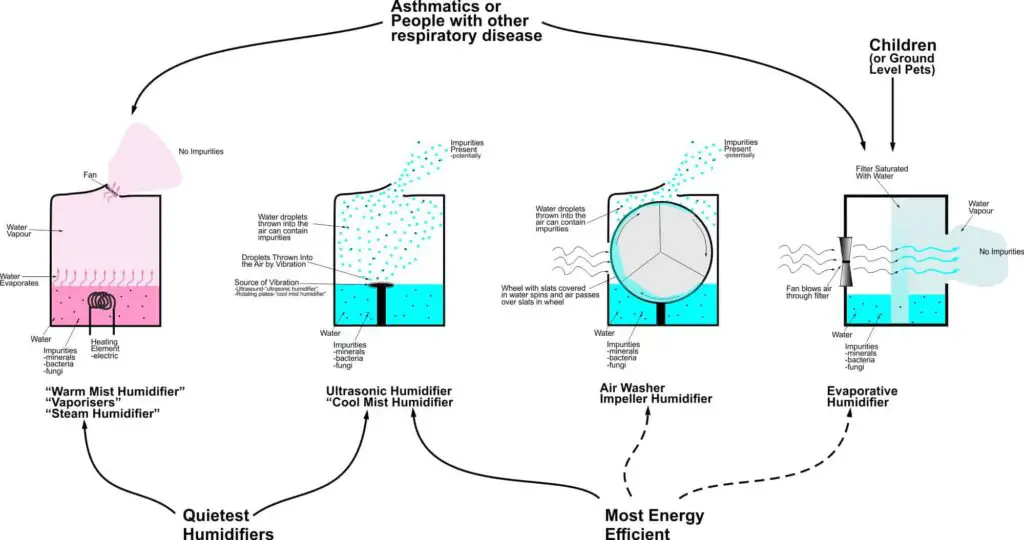
Related Questions
See Also
The Difference Between an Air Purifier and a Humidifier-13 Important Health Effects

Whole House Humidifier-7 Reasons It Is So Much Better Than Several Portable Units

Do Humidifiers Help With Asthma? Yes in 2 Important Ways


